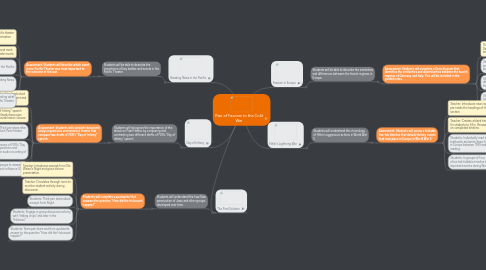
1. Day of Infamy
1.1. Students will recognize the importance of the attack on Pearl Harbor by comparing and contrasting two different drafts of FDR’s “Day of Infamy” speech
1.1.1. Assessment: Students will complete document analysis questions and sentence frames that compare two drafts of FDR's "Day of Infamy" speech.
1.1.1.1. Teacher: Plays short Pearl Harbor film, leads short discussion about film, and introduces content and academic vocabulary.
1.1.1.2. Teacher: Plays audio of "Day of Infamy" speech while students read along and leads discussion about students' findings to provide lesson closure.
1.1.1.3. Students: Think pair share after watching short Pearl Harbor film.
1.1.1.4. Students: Read and analyze two different versions of FDR's "Day of Infamy" and complete document analysis questions and sentence frames. Students will also listen to an audio recording of the speech.
1.1.1.5. Students: Will work in small groups to answer the question "How did FDR’s speech influence US involvement in World War II"
2. Breaking News in the Pacific
2.1. Students will be able to describe the importance of key battles and events in the Pacific Theater.
2.1.1. Assessment: Students will describe which event in the Pacific Theater was most important to the outcome of the war.
2.1.1.1. Teacher: Lectures about Pacific theater while showing Pacific map animation clip.
2.1.1.2. Teacher: Takes poll about most important Pacific Theater event.
2.1.1.3. Students: Role play a news broadcast performance about a specific event in the Pacific Theater.
2.1.1.4. Students: Complete Breaking News graphic organizer during presentations.
2.1.1.5. Students: Complete quickwrite detailing what they think the most important Pacific Theater event was.
3. The Final Solution
3.1. Students will understand the how Nazi persecution of Jews and other groups developed over time.
3.1.1. Students will complete a quickwrite that answers the question “How did the Holocaust happen?”
3.1.1.1. Teacher: Introduces excerpt from Elie Weisel's Night and gives lecture presentation.
3.1.1.2. Teacher: Circulates through room to monitor student activity during discussion.
3.1.1.3. Students: Think pair share about excerpt from Night.
3.1.1.4. Students: Engage in group discussion activity with "talking chips" and later in the "fishbowl."
3.1.1.5. Students: Team pair share and then quickwrite answer to the question "How did the Holocaust happen?"
4. Fascism in Europe
4.1. Students will be able to describe the similarities and differences between the fascist regimes in Europe.
4.1.1. Assessment: Students will complete a Venn diagram that identifies the similarities and dissimilarities between the fascist regimes of Germany and Italy. This will be included in the guided notes.
4.1.1.1. Teacher: Prompts initial quickwrite activity. Delivers lecture with aid of Prezi presentation and hands out guided notes.
4.1.1.2. Students: Complete initial quickwrite accessing prior knowledge of European economy and politics.
4.1.1.3. Students: Use guided notes to follow lecture, define new vocabulary, and answer critical thinking questions.
4.1.1.4. Students: Complete Venn diagram comparing and contrasting fascist regimes.
5. Hitler's Lightning War
5.1. Students will understand the chronology of Hitler's aggressive actions in World War II.
5.1.1. Assessment: Students will create a foldable five-tab timeline that details the key events that took place in Europe in World War II.
5.1.1.1. Teacher: Introduces new vocabulary and pre-reads the headings of the reading section.
5.1.1.2. Teacher: Creates a blank timeline on the board for students to fill in. Reviews chronology based on completed timeline.
5.1.1.3. Students: Individually read the first section in chapter 16 of their textbooks and write down five important events that took place in Europe between 1939 and 1941 while they complete the reading.
5.1.1.4. Students: In groups of four, students will create a five-tab foldable timeline that details five important events during World War II.
